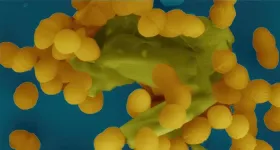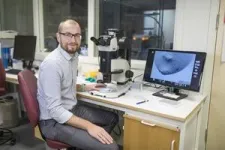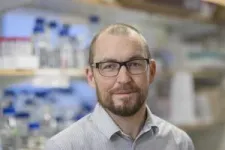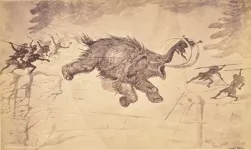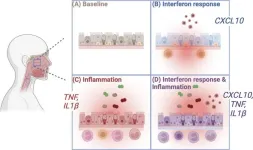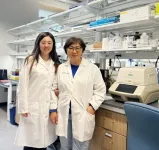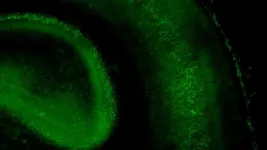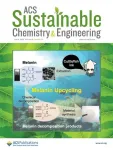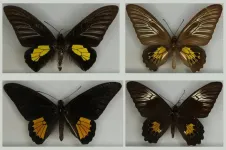(Press-News.org) A study at Umeå University, Sweden, provides new clues in the understanding of how antibiotic resistance spreads. The study shows how an enzyme breaks down the bacteria's protective outer layer, the cell wall, and thus facilitates the transfer of genes for resistance to antibiotics.
"You could say that we are adding a piece of the puzzle to the understanding of how antibiotic resistance spreads between bacteria," says Ronnie Berntsson, Associate Professor at Umeå University and one of the authors behind the study.
The Umeå researchers have studied Enterococcus faecalis, which is a bacterium that often causes hospital infections, where in many cases treatment with antibiotics no longer bites because the bacteria have developed resistance. These bacteria can also spread the resistance further via the type 4 secretion systems, T4SS. It is a kind of protein complex that acts as a copying device, allowing properties in the form of genetic material to be spread to other bacteria. Resistance to antibiotics is one such trait that can be moved between bacteria with the help of T4SS.
An important part of T4SS is the enzyme PrgK, which breaks down the bacterial cell wall and thus facilitates the transfer of properties between bacteria. This enzyme has three parts or domains, LytM, SLT, and CHAP.
PrgK works like scissors that cut into the bacterial cell wall. Contrary to what the researchers previously thought, it turned out that only the SLT domain was active, but in a different way than expected. The other two domains instead turned out to have an important role in the regulation of the enzyme. The researchers also identified that another T4SS protein, PrgL, binds to PrgK and ensures that it ends up in the right place in the protein machinery.
"The findings are important for continued research into how to prevent T4SS from transferring properties such as resistance to antibiotics to other bacteria," says Josy ter Beek, Staff scientist at Umeå University.
The study has been conducted through a combination of biochemical analyses of the protein linked to functional studies in vivo, and supplemented with structural studies of PrgK using both X-ray crystallography and AlphaFold modelling.
END
Degradation of cell wall key in the spread of resistance
2024-07-01
ELSE PRESS RELEASES FROM THIS DATE:
The evidence is mounting: humans were responsible for the extinction of large mammals
2024-07-01
The debate has raged for decades: Was it humans or climate change that led to the extinction of many species of large mammals, birds, and reptiles that have disappeared from Earth over the past 50,000 years?
By "large," we mean animals that weighed at least 45 kilograms – known as megafauna. At least 161 species of mammals were driven to extinction during this period. This number is based on the remains found so far.
The largest of them were hit the hardest – land-dwelling herbivores weighing over a ton, the megaherbivores. Fifty thousand years ago, there were 57 species of megaherbivores. Today, only 11 remain. These remaining ...
Common respiratory infections may have protected children from COVID-19, study suggests
2024-07-01
Analyzing nasal swabs taken during the pandemic, researchers at Yale School of Medicine suggest that the frequent presence of other viruses and bacteria may have helped to protect children from the worst effects of COVID-19 by boosting their immune systems. Their results will be published July 1 in the Journal of Experimental Medicine (JEM).
Children are generally more susceptible than adults to respiratory infections such as the common cold, and yet, for unknown reasons, the SARS-CoV-2 virus tends to cause less severe ...
Ochsner Medical Center – Baton Rouge performs robotic-assisted lung biopsy
2024-07-01
BATON ROUGE, La. – Ochsner Medical Center – Baton Rouge now offers robotic-assisted bronchoscopy using the Ion robotic platform, a new, minimally invasive option for lung biopsy.
With bronchoscopy, doctors insert a long, thin tube with a camera to examine lung tissue and retrieve a biopsy sample. The Ion robot enables doctors to perform a biopsy quicker and safer than ever before.
These advancements are especially critical for treating lung cancer, since early detection is key to achieving the best outcome. Every six weeks of delayed treatment lowers ...
Daily sauna time might help prevent menopause-related weight gain
2024-07-01
Chicago (July 1, 2024) — New research performed with mice suggests that daily time in a warm environment such as a sauna might help older adults, especially women, combat age-related obesity and insulin resistance. The study shows the potential of heat treatments as a simple way to promote healthier aging.
The researchers found that older female mice receiving a daily 30-minute whole-body heat treatment gained less weight and showed improved use of insulin, which helps control blood sugar. The investigators ...
Researchers thwart resistant bacteria’s strategy
2024-07-01
Antibiotic resistant bacteria are experts in evolving new strategies to avoid being killed by antibiotics.
One such bacterium is Pseudomonas aeruginosa, which is naturally found in soil and water, but also hospitals, nursing homes and similar institutions for persons with weakened immune systems are home for strains of this bacterium. As many P. Aeruginosa strains found in hospitals are resistant to most antibiotics in use, science is forced to constantly search for new ways to kill them.
Now, at team of researchers from Department of Biochemistry and Molecular Biology and Department of ...
Finding the sweet spot in brain development
2024-07-01
Not everything in the brain is meant to last. As our brains assemble, trillions of neural connections have to be built or torn down at the right time and place. Otherwise, the seeds of disorders like autism can take root. Cold Spring Harbor Laboratory Assistant Professor Gabrielle Pouchelon studies how the brain is wired early in life. In doing so, she hopes to find the origins of various brain dysfunctions and new ways to treat them.
In a new study, Pouchelon and her team zero in on a process known as pruning. This is when the brain removes unnecessary connections between ...
New national volunteer leaders to guide American Heart Association into second century
2024-07-01
DALLAS, July 1, 2024 — The American Heart Association, celebrating 100 years of lifesaving service as the world’s leading nonprofit organization focused on heart and brain health for all, has named its volunteer leadership for fiscal year 2024-25. Keith Churchwell, M.D., FAHA, serving as the new volunteer president, and Marsha Jones, continuing a two-year term as volunteer board chairperson, will help guide the Association as it enters its second century. Churchwell and Jones are long-time volunteer leaders for ...
Geological Society of America reduces student membership dues to $25
2024-07-01
FOR IMMEDIATE RELEASE
1 July 2024
The Geological Society of America
Release No. 24-06
Contact: Jason Elkins
+1-303-357-1026
jelkins@geosociety.org
Boulder, Colo., USA: The Geological Society of America (GSA) is excited to announce a significant reduction in membership fees for students. Effective 1 July 2024, undergraduate and graduate students majoring in geology or related sciences can sign up for an annual student membership for just $25. This initiative underscores GSA's commitment to supporting the next generation of geoscientists by making membership more accessible and affordable.
The ...
Melanin from cuttlefish ink as a sustainable biomass resource
2024-07-01
Every year, the negative effects of human activities on the environment become increasingly clear. From climate change and microplastics to the endangerment and extinction of countless species, it is evident that we need to find new ways to achieve sustainability. Fortunately, many research groups in prominent fields like chemistry and materials science are tirelessly working to develop solutions to get us closer to circular and sustainable economies.
One area that has attracted much attention in this regard is biomass upcycling. It refers to the transformation of naturally available organic materials into ...
AI-powered study explores under-studied female evolution
2024-07-01
Pioneering AI-powered research on butterflies has probed the under-studied evolution of females and adds to a debate between the founding fathers of evolution.
The University of Essex study – published in Communications Biology – explores a controversy between Victorian scientists Charles Darwin and Alfred Russel Wallace.
Darwin thought males had more variation, as females often chose mates based on male appearance.
Whereas Wallace thought natural selection across sexes was the biggest factor in difference.
For over a century, scientists ...
